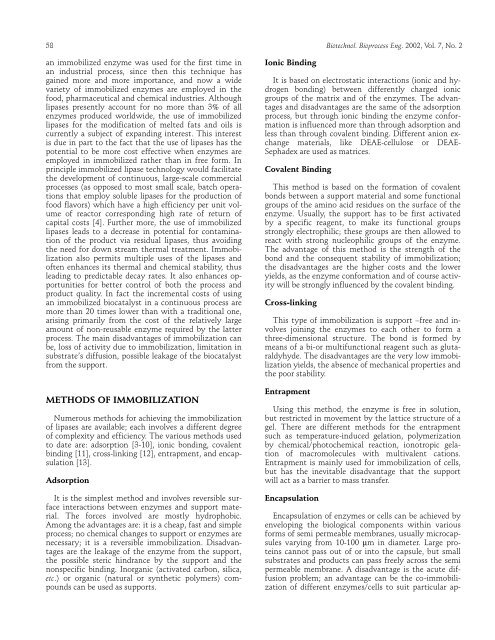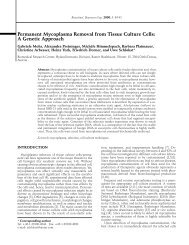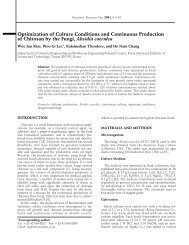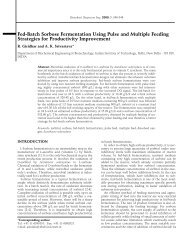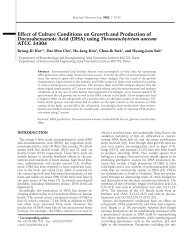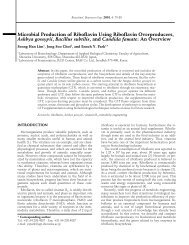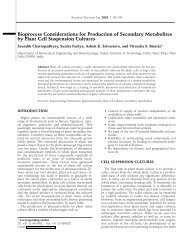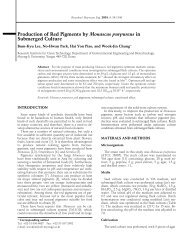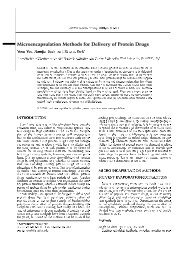Hydrolysis of Oils by Using Immobilized Lipase Enzyme: A Review
Hydrolysis of Oils by Using Immobilized Lipase Enzyme: A Review
Hydrolysis of Oils by Using Immobilized Lipase Enzyme: A Review
Create successful ePaper yourself
Turn your PDF publications into a flip-book with our unique Google optimized e-Paper software.
58 Biotechnol. Bioprocess Eng. 2002, Vol. 7, No. 2<br />
<br />
an immobilized enzyme was used for the first time in Ionic Binding<br />
an industrial process, since then this technique has<br />
gained more and more importance, and now a wide<br />
variety <strong>of</strong> immobilized enzymes are employed in the<br />
food, pharmaceutical and chemical industries. Although<br />
lipases presently account for no more than 3% <strong>of</strong> all<br />
enzymes produced worldwide, the use <strong>of</strong> immobilized<br />
lipases for the modification <strong>of</strong> melted fats and oils is<br />
currently a subject <strong>of</strong> expanding interest. This interest<br />
It is based on electrostatic interactions (ionic and hydrogen<br />
bonding) between differently charged ionic<br />
groups <strong>of</strong> the matrix and <strong>of</strong> the enzymes. The advantages<br />
and disadvantages are the same <strong>of</strong> the adsorption<br />
process, but through ionic binding the enzyme conformation<br />
is influenced more than through adsorption and<br />
less than through covalent binding. Different anion exchange<br />
is due in part to the fact that the use <strong>of</strong> lipases has the<br />
materials, like DEAE-cellulose or DEAE-<br />
potential to be more cost effective when enzymes are Sephadex are used as matrices.<br />
employed in immobilized rather than in free form. In<br />
principle immobilized lipase technology would facilitate Covalent Binding<br />
the development <strong>of</strong> continuous, large-scale commercial<br />
processes (as opposed to most small scale, batch operations<br />
that employ soluble lipases for the production <strong>of</strong><br />
food flavors) which have a high efficiency per unit volume<br />
<strong>of</strong> reactor corresponding high rate <strong>of</strong> return <strong>of</strong><br />
capital costs [4]. Further more, the use <strong>of</strong> immobilized<br />
lipases leads to a decrease in potential for contamination<br />
<strong>of</strong> the product via residual lipases, thus avoiding<br />
the need for down stream thermal treatment. Immobilization<br />
also permits multiple uses <strong>of</strong> the lipases and<br />
<strong>of</strong>ten enhances its thermal and chemical stability, thus<br />
leading to predictable decay rates. It also enhances opportunities<br />
for better control <strong>of</strong> both the process and<br />
This method is based on the formation <strong>of</strong> covalent<br />
bonds between a support material and some functional<br />
groups <strong>of</strong> the amino acid residues on the surface <strong>of</strong> the<br />
enzyme. Usually, the support has to be first activated<br />
<strong>by</strong> a specific reagent, to make its functional groups<br />
strongly electrophilic; these groups are then allowed to<br />
react with strong nucleophilic groups <strong>of</strong> the enzyme.<br />
The advantage <strong>of</strong> this method is the strength <strong>of</strong> the<br />
bond and the consequent stability <strong>of</strong> immobilization;<br />
the disadvantages are the higher costs and the lower<br />
yields, as the enzyme conformation and <strong>of</strong> course activity<br />
will be strongly influenced <strong>by</strong> the covalent binding.<br />
product quality. In fact the incremental costs <strong>of</strong> using<br />
an immobilized biocatalyst in a continuous process are Cross-linking<br />
more than 20 times lower than with a traditional one,<br />
arising primarily from the cost <strong>of</strong> the relatively large<br />
amount <strong>of</strong> non-reusable enzyme required <strong>by</strong> the latter<br />
process. The main disadvantages <strong>of</strong> immobilization can<br />
be, loss <strong>of</strong> activity due to immobilization, limitation in<br />
substrate’s diffusion, possible leakage <strong>of</strong> the biocatalyst<br />
from the support.<br />
This type <strong>of</strong> immobilization is support –free and involves<br />
joining the enzymes to each other to form a<br />
three-dimensional structure. The bond is formed <strong>by</strong><br />
means <strong>of</strong> a bi-or multifunctional reagent such as glutaraldyhyde.<br />
The disadvantages are the very low immobilization<br />
yields, the absence <strong>of</strong> mechanical properties and<br />
the poor stability.<br />
METHODS OF IMMOBILIZATION<br />
Numerous methods for achieving the immobilization<br />
<strong>of</strong> lipases are available; each involves a different degree<br />
<strong>of</strong> complexity and efficiency. The various methods used<br />
to date are: adsorption [3-10], ionic bonding, covalent<br />
binding [11], cross-linking [12], entrapment, and encapsulation<br />
[13].<br />
Adsorption<br />
It is the simplest method and involves reversible surface<br />
interactions between enzymes and support material.<br />
The forces involved are mostly hydrophobic.<br />
Among the advantages are: it is a cheap, fast and simple<br />
process; no chemical changes to support or enzymes are<br />
necessary; it is a reversible immobilization. Disadvantages<br />
are the leakage <strong>of</strong> the enzyme from the support,<br />
the possible steric hindrance <strong>by</strong> the support and the<br />
nonspecific binding. Inorganic (activated carbon, silica,<br />
etc.) or organic (natural or synthetic polymers) compounds<br />
can be used as supports.<br />
Entrapment<br />
<strong>Using</strong> this method, the enzyme is free in solution,<br />
but restricted in movement <strong>by</strong> the lattice structure <strong>of</strong> a<br />
gel. There are different methods for the entrapment<br />
such as temperature-induced gelation, polymerization<br />
<strong>by</strong> chemical/photochemical reaction, ionotropic gelation<br />
<strong>of</strong> macromolecules with multivalent cations.<br />
Entrapment is mainly used for immobilization <strong>of</strong> cells,<br />
but has the inevitable disadvantage that the support<br />
will act as a barrier to mass transfer.<br />
Encapsulation<br />
Encapsulation <strong>of</strong> enzymes or cells can be achieved <strong>by</strong><br />
enveloping the biological components within various<br />
forms <strong>of</strong> semi permeable membranes, usually microcapsules<br />
varying from 10-100 µm in diameter. Large proteins<br />
cannot pass out <strong>of</strong> or into the capsule, but small<br />
substrates and products can pass freely across the semi<br />
permeable membrane. A disadvantage is the acute diffusion<br />
problem; an advantage can be the co-immobilization<br />
<strong>of</strong> different enzymes/cells to suit particular ap-


